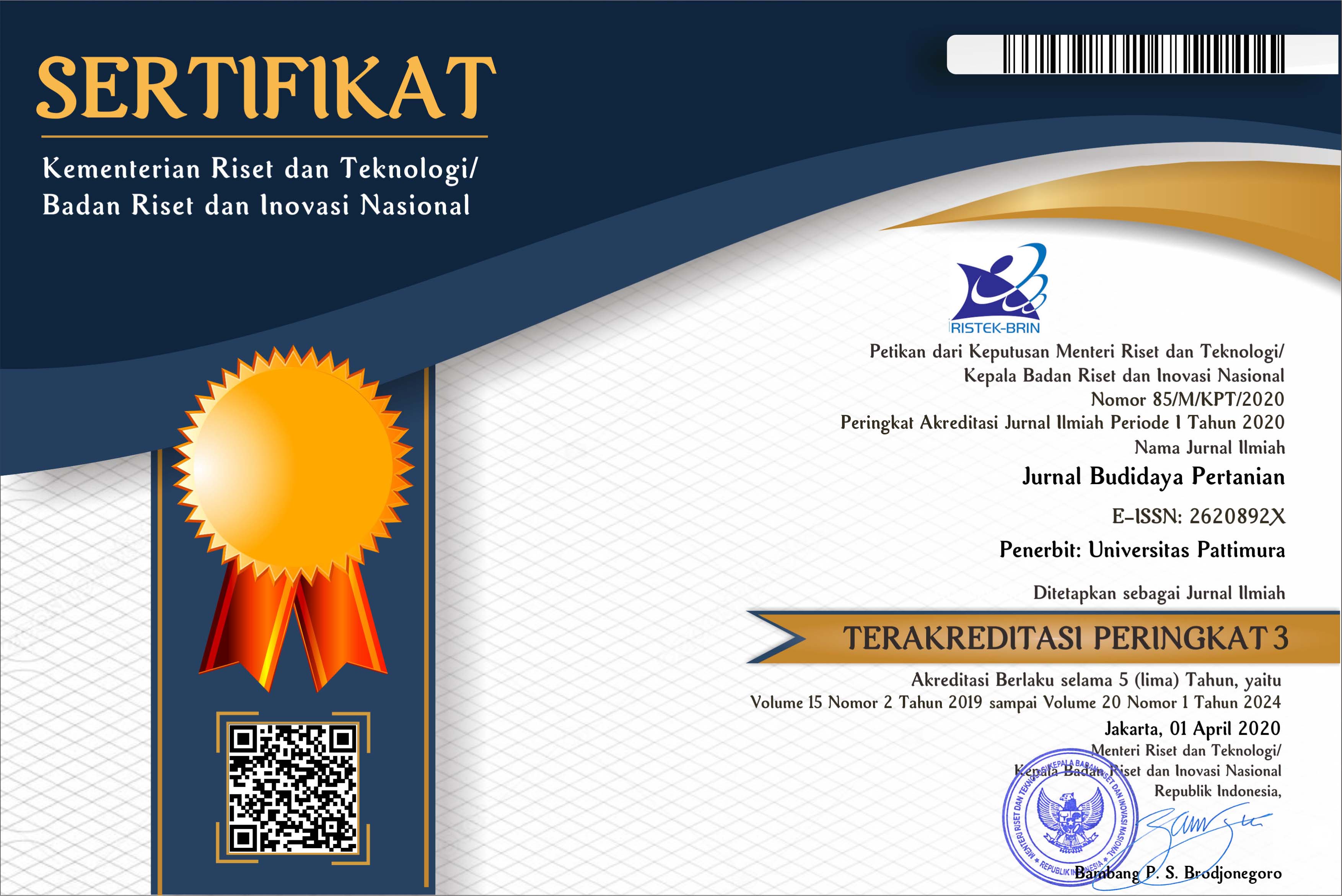Preferensi Serangga Herbivora Henosepilachna sp (Coleoptera: Coccinellidae) terhadap Beberapa Jenis Tanaman Budidaya
Preference of Henosepilachna sparsa (Coleoptera: Coccinellidae) Herbivore Insect on Several Types of Cultivated Plants
Abstract
Herbivorous insects and plants have a very complex interaction relationship, where plants play an important role in shaping the behavior and development of herbivorous insects. Nutrients contained in plants in the form of secondary compounds also determine whether or not plants were selected by insects. The objective of the research was to study the preferences of Henosepilachna sparsa herbivorous insects on several cultivated plants. The study was conducted in October 2013 at the Toxicology Laboratory, Department of Plant Protection, Faculty of Agriculture, Bogor Agricultural University. The steps of the experiments were: a) Extracting plant materials such as takokak, eggplant, tomatoes, and broccoli using hexane and methanol solvents; and b) imago H. sparsa preference of plant was takokak plant extract with methanol solvent, takokak plant material with Hexane solvent, tomato plant with Methanol solvent, tomato plant material with Hexane solvent, eggplant plant material with Methanol solvent, eggplant material with Hexane solvent, broccoli with Methanol solvent), broccoli plant material with Hexane solvent was carried out using a three-branched olfactometer (Y form). Imago H. sparsa of plant extract was taken from around the taro plant in Bogor. The results of the study show that the imago H. sparsa insect preference test for extraction of test plants using hexane solvents was better than methanol solvents. Extraction of eggplant plants with hexane solvents has the highest retention value (Rf) of 0.751 cm with the assumption that the higher the Rf value, the more metabolites are detected.
Keywords: allelochemics, attractants, broccoli, eggplant, repellent, tomatoes, takokak
ABSTRAK
Serangga herbivora dan tanaman memiliki hubungan interaksi yang sangat kompleks, dimana tanaman mempunyai peran yang penting dalam membentuk perilaku dan perkembangan serangga herbivora. Nutrisi yang dikandung tanaman berupa senyawa sekunder juga menentukan dipilih atau tidak dipilih suatu tanaman oleh serangga. Penelitian bertujuan untuk mempelajari preferensi serangga herbivora Henosepilachna sparsa pada beberapa tanaman budidaya. Penelitian dilaksanakan pada bulan Oktober 2013 di Laboratorium Toksikologi, Departemen Proteksi Tanaman Fakultas Pertanian, Institut Pertanian Bogor. Tahapan penelitian meliputi: a) Ekstraksi bahan-bahan tanaman seperti takokak, terung, tomat, dan brokoli dengan menggunakan pelarut heksana dan metanol; dan b) Preferensi imago H. Sparsa terhadap ekstrak bahan tanaman takokak dengan pelarut Metanol, bahan tanaman takokak dengan pelarut Heksana, bahan tanaman tomat dengan pelarut Metanol, bahan tanaman tomat dengan pelarut Heksana, bahan tanaman terung dengan pelarut Metanol, bahan tanaman terung dengan pelarut Heksana, bahan tanaman brokoli dengan pelarut Metanol, bahan tanaman brokoli dengan pelarut Heksana dilakukan menggunakan olfaktometer yang bercabang tiga (bentuk Y). Imago H. sparsa diambil dari sekitar pertanaman talas di Bogor. Hasil penelitian menunjukkan bahwa uji preferensi serangga imago H. sparsa terhadap ekstraks tanaman uji menggunakan pelarut heksana lebih baik dari pelarut metanol. Ekstraksi tanaman terung dengan pelarut heksana memiliki nilai retensi tertinggi (Rf) 0,751 cm dengan dugaan bahwa semakin tinggi nilai Rf maka semakin banyak senyawa metabolit yang terdeteksi.
Kata Kunci: allelokemik, atraktan, brokoli, repelen, takokak, terung, tomat
Downloads
References
Ansel. 1989. Pengantar Bentuk Sediaan Farmasi. Jakarta: UI Press.
Dadang, dan K. Ohsawa. 2000. Penghambat aktivitas makan larva Plutella xylostella (L). (Lepidoptera: Yponomeutidae) yang diperlakukan ekstrak biji Swietenia mahogany Jacq. (Meliaceae). Buletin Hama dan Penyakit 12: 27-32.
Dadang, dan D. Prijono. 2008. Insektisida Nabati: Prinsip, Pemanfaatan, dan Pengembangan. Penerbit: Departemen Proteksi Tanaman. Fakultas Pertanian, Institut Pertanian Bogor.
Ehrlich, P.R. and P.H. Raven. 1967. Butterflies and plants: A study in coevolution. Evolution 18: 586-608.
Grainge, M. and S. Ahmed. 1988. Handbook of Plants with Pest-Control Properties. New York : John Wiley & Sons.
Harborne, J.B. 1984. Phytochemical Methods. Ed ke-2. New York: Chapman and Hall.
Indrayani, I.G.A.A. 2008. Peranan morfologi tanaman untuk mengendalikan pengisap daun, Amrasca biguttula (Ishida) pada tanaman kapas. Perspektif 7: 47-54. DOI: 10.21082/p.v7n1.2008.%25p
Kalshoven, L.G.E. 1981. Pest of crops in Indonesia. PT Ichtiar Baru-Van Hoeve, Jakarta.
Kennedy, J.S. 1965. Mechanism of host plant selection. Annals of Applied Biology 56: 317-322. DOI: 10.1111/j.1744-7348.1965.tb01242.x
Kogan, M. 1982. Plant Resistance In Pest Management. In; Metcalf, R.L., and W.H. Luckmann (Eds.). Introduction to Insect Pest Management. Second Edition. New York: John Wiley & Sons. Pp 93-134.
Metcalf, R.L. and W. Luckmann. 1975. Introduction To Insect Pest Management. John Wiley and Sons, New York. 587 pp.
Schoonhoven, L.M., J.J.A. van Loon, and D. Marcel. 2005. Insect-Plant Biology. Second edition. Oxford University Press.
Whittaker, R.H. and P.P. Feeny. 1971. Allelochemics: Chemical interaction between species. Science 171: 757-770.

 Accreditation is valid for 5 years, starting from Volume 15 Issues 2 December 2019 up to Volume 20 Issue 1 June 2024.
Accreditation is valid for 5 years, starting from Volume 15 Issues 2 December 2019 up to Volume 20 Issue 1 June 2024.






